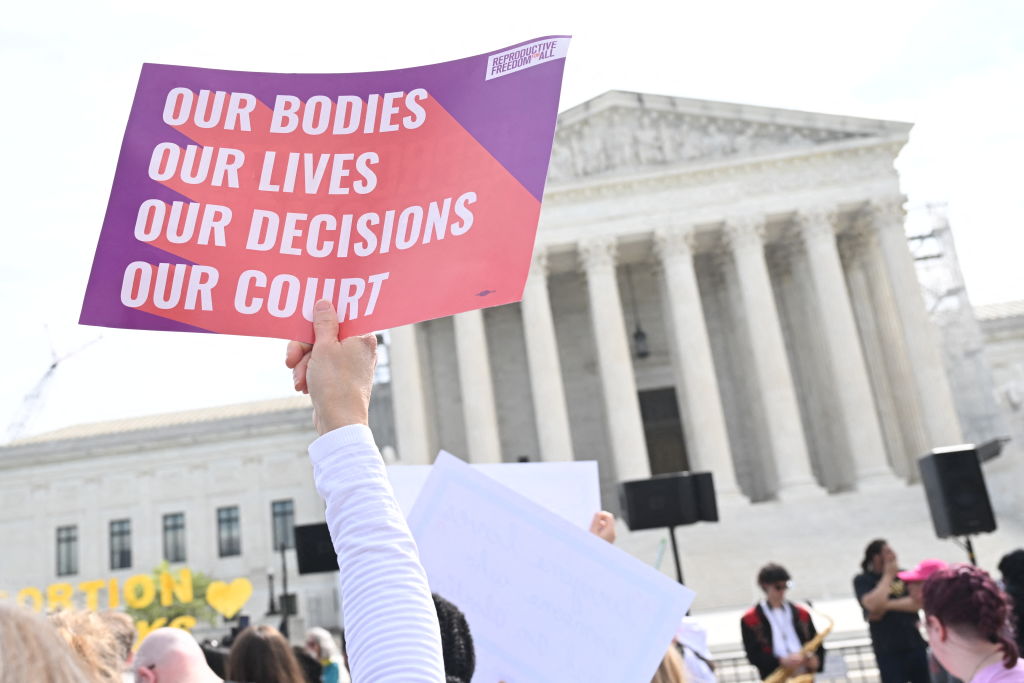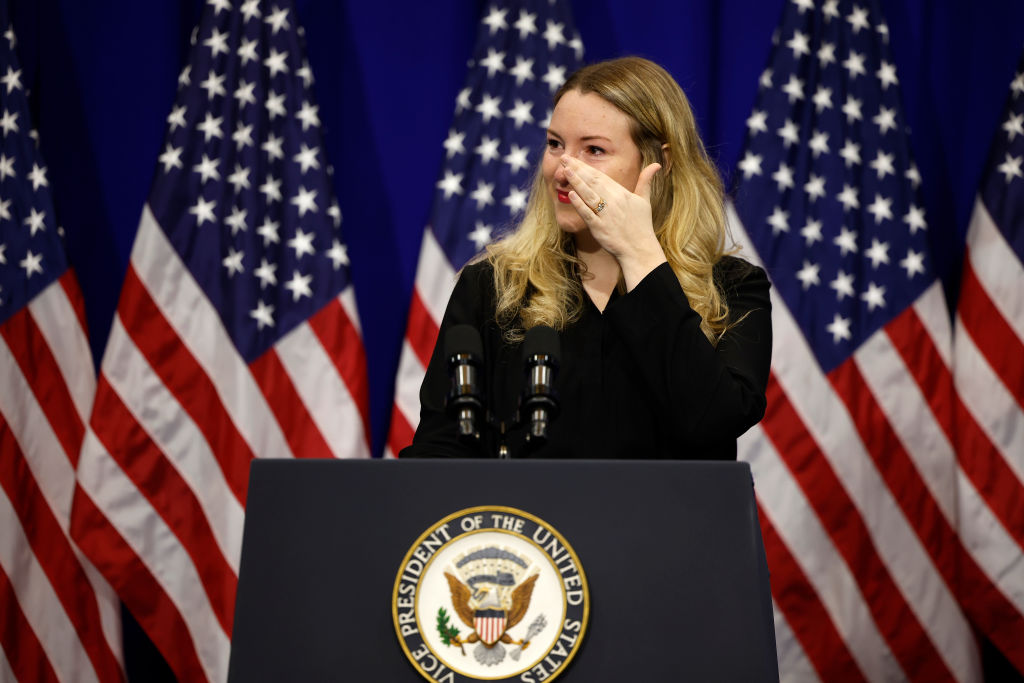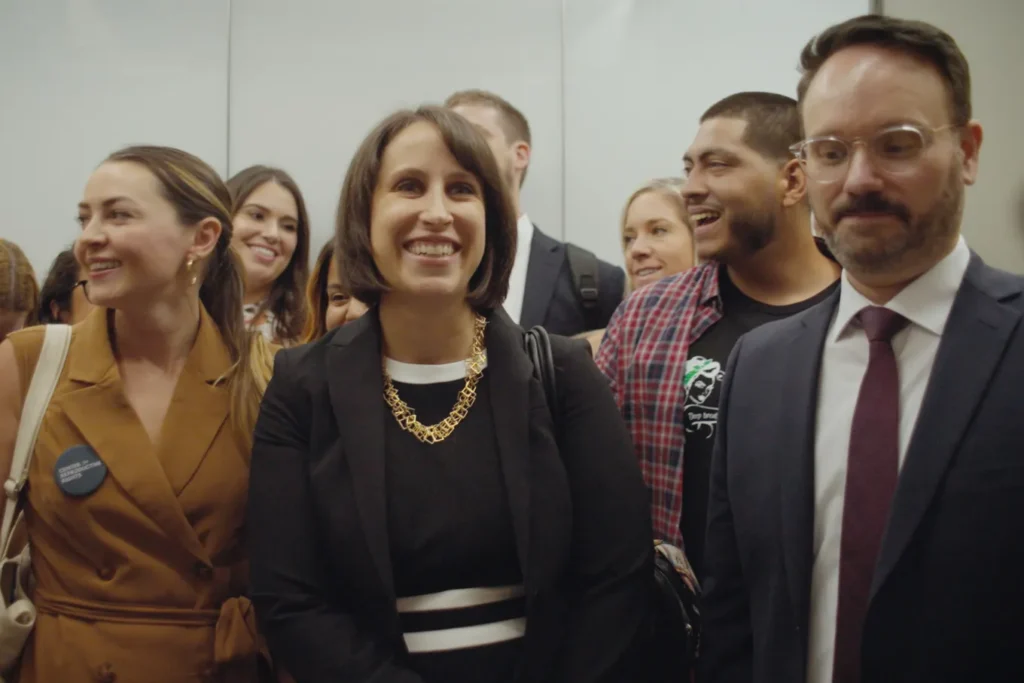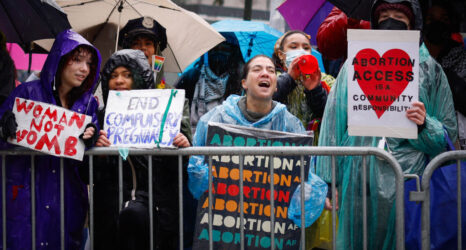As abortion access is increasingly being decided by state and federal courts, two reproductive rights attorneys make sense of past rulings and the ongoing fight for reproductive healthcare.

Before signing off for the summer, the Supreme Court handled the much-anticipated abortion-related case of Moyle v. United States by … not handling it at all. Instead, it punted the underlying question—must state abortion bans provide an exemption when a woman’s health is at risk, not only her life?—to a more politically convenient time. The ruling confused reproductive rights supporters who followed the case closely, as well as women living in abortion ban states.
Women in one particular abortion ban state, Texas, had already been reeling from a callous ruling issued just a few weeks earlier—this one from the state Supreme Court—that forces pregnancy on women until (and even past) the brink of death and mandates them to continue pregnancies even when their fetus has no chance of survival after birth.
To make sense of the two rulings, as well as the broader legal landscape on abortion rights, Ms. spoke to Marc Hearron of Center for Reproductive Rights, the legal organization that brought the Texas suit (Zurawski v. Texas) on behalf of two doctors and 20 Texas women with pregnancy complications denied abortion care, including some who almost died; and Jaime Gher of Global Justice Center, an international humanitarian law organization that has argued many times in court that abortion bans are inconsistent with international human rights protections.
This interview has been lightly edited for clarity. The following questions, as well as Hearron’s and Gher’s responses, were provided via through a combination of Zoom and email, in collaboration with the two legal organizations.
Ms. magazine: Center for Reproductive Rights just asked the Biden administration to investigate a case of two Texas women who were denied abortions despite having life-threatening pregnancies. What happened to these women, and what response are you seeking from the Biden administration?
Jaime Gher and Marc Hearron: Kyleigh Thurman and Kelsie Norris-De La Cruz were both diagnosed with a nonviable ectopic pregnancy—this condition is extremely dangerous and can kill the patient if not treated promptly. Despite a clear diagnosis of an ectopic pregnancy from their physicians, both were repeatedly turned away from two hospitals. Thurman and Norris-De La Cruz recounted how they nearly died after being forced to wait so long for care.
In the end, they both lost a fallopian tube, compromising their future fertility.
There are explicit exceptions for ectopic pregnancies in Texas’ abortion ban. But in practice, the threat of prosecution for abortion providers has made doctors across the state afraid to perform any abortions. This phenomenon is taking place across the U.S., leading OB-GYNs to flee states like Idaho in droves.
In Thurman’s and Norris-De La Cruz’s cases, Center for Reproductive Rights is asking the federal government to enforce the Emergency Medical Treatment and Labor Act (EMTALA), which requires hospitals to provide stabilizing care—including abortions—to patients with emergency medical conditions. EMTALA applies regardless of any particular state’s law, so the Biden administration should hold these hospitals accountable for denying these women urgently needed care.
Ms. magazine: The Supreme Court recently ruled in a case considering the enforcement of EMTALA. What exactly did the Court do, and how does the ruling impact abortion seekers nationwide?
Gher and Hearron: The Court essentially kicked the can down the road. They dismissed a case about whether EMTALA takes precedence over Idaho’s near-total abortion ban, which prohibits abortions unless a physician could prove the abortion was necessary to prevent the death of the pregnant person—but it’s unclear how close to death a person must be.
The Supreme Court’s ruling, in turn, reinstated a lower court decision that, for now, blocks the enforcement of Idaho’s near-total abortion ban when it conflicts with EMTALA. But as Justice Ketanji Brown Jackson noted in her searing dissent, the ruling “is not a victory for pregnant patients in Idaho. It is delay.”
More critically, the ruling leaves pregnant people and abortion providers across the country without any clear guidance on when they are safe to perform life-saving and health-preserving emergency abortions.
“This court had a chance to bring clarity and certainty to this tragic situation and we have squandered it,” wrote Jackson.
This limbo will have dire consequences. In amicus briefs filed in this case, the Center for Reproductive Rights and Global Justice Center cited several instances in which pregnant people were denied abortions despite serious medical complications. These dangerous denials of care occurred across several different states, most of which have exceptions written into their abortion bans that supposedly allow abortions in emergency situations.
There are explicit exceptions for ectopic pregnancies in Texas’ abortion ban. But … the threat of prosecution for abortion providers has made doctors across the state afraid to perform any abortions.
Jaime Gher and Marc Hearron

Ms. magazine: The Texas Supreme Court has issued two rulings in the last year concerning the availability of emergency abortion care—in the Zurawski v. Texas case, as well as overturning a district court ruling that would have allowed Kate Cox, a 31-year-old Texas woman, to end her nonviable pregnancy.
What’s the state of abortion care in Texas following these rulings?
Gher and Hearron: These two high-profile rulings largely upheld the dangerous status quo in Texas, which is one that forces pregnant people to carry dangerous pregnancies to term and leaves physicians under constant threat of prosecution.
In December 2023, the court ruled that Kate Cox could not get an abortion in Texas despite a diagnosis of trisomy 18—a nonviable fetal condition that can jeopardize the health and future fertility of the pregnant person. Cox had to get abortion care out of state while waiting for the court to rule.
In Zurawski v. Texas, decided in May, the court ruled against 20 women who were denied abortion care despite their dangerous pregnancy complications. It wholly dismissed their claims that Texas law violates their constitutional rights to life and health. Perhaps most chilling was the part of the ruling stating abortions are not permitted when the fetus has a lethal condition—unless the pregnant patient also has a life-threatening condition.
The court did clarify that abortions are permitted if the pregnant person’s life is at stake, but it refused to say precisely when the life exception applies as a patient’s health deteriorates.
The Texas Medical Board was supposed to offer guidance, and it did publish a set of rules in June of this year. But it fell far short of delivering the clear and comprehensive guidance that physicians need to protect their patients’ health and lives, as well as protect themselves from prosecution and other punishment.
Ultimately, these cases confirmed that pregnant people are not safe under abortion bans, no matter what exceptions may appear on paper.

Ms. magazine: The horrific state of abortion rights in Texas and elsewhere has motivated international human rights bodies to call out the United States for failing to live up to its human rights obligations. What human rights are implicated here, and how have international human rights experts responded to the crisis in the U.S.?
Gher and Hearron: The United States has ratified several foundational human rights treaties and is legally obligated to protect the rights outlined in them. These treaties include the International Convention on Civil and Political Rights (ICCPR) and the Convention Against Torture (CAT), and they protect rights to life, privacy, freedom from torture, discrimination and more.
Even with treaties the United States has not signed—such as the Convention on the Elimination of All Forms of Discrimination Against Women—it is bound by customary international law not to take actions that “defeat the object and purpose” of a treaty.
Abortion bans clearly and explicitly violate a number of these human rights:
- The right to life is violated when life-saving abortion care is made virtually inaccessible, as it has been in Texas.
- The right to privacy is violated because abortion bans undermine a pregnant person’s reproductive autonomy.
- The right to be free from torture and other cruel, inhuman and degrading treatment is violated when a pregnant individual is compelled to continue a pregnancy following a fatal fetal diagnosis.
The human rights bodies that monitor treaty compliance have repeatedly reinforced these interpretations of the treaties. This is exactly what happened in the wake of the Supreme Court’s Dobbs v. Jackson Women’s Health Organization ruling that overturned Roe v. Wade.
The U.N. Human Rights Committee, which monitors compliance with ICCPR, issued findings in November 2023 that noted the “profound impact” of extreme abortion restrictions in the USA on “the rights of women and girls seeking an abortion, including the rights to life, to privacy and not to be subjected to cruel and degrading treatment.”
The U.N. Committee on the Elimination of Racial Discrimination (CERD), which monitors compliance with the treaty that explicitly prohibits racial discrimination, issued similarly stark findings against the U.S. in the wake of Roe’s reversal.
Ms. magazine: So far we’ve focused on individuals seeking abortion in cases where they are suffering from serious medical conditions. But what’s the broader state of abortion care? What other significant cases are making their way through the courts?
Gher and Hearron: Though much attention has rightly been paid to these horrific cases of neglect in emergency medical situations, we must remember that these cases make up only a tiny percentage of people who seek abortion care. People need abortions for many reasons, from financial troubles to unexpected life circumstances.
A professor in the University of Michigan’s Department of Internal Medicine described how abortion bans challenge doctors’ ability to provide cancer treatment in a timely manner. This is because treatments such as chemotherapy and radiation can harm a fetus, particularly during early pregnancy.
Beyond pregnancy, antiabortion laws can increase the risk of violence for pregnant individuals who are exposed to abusive relationships, as the inability to obtain an abortion can force victims to remain with their abusers. All of these harms are compounded by existing socioeconomic disparities, making abortion bans a driver of further marginalization for Black, Indigenous, people of color, migrants and other multi-marginalized populations.
As for other major cases, reproductive rights organizations continue to respond to the antiabortion movement’s diverse and escalating attacks on abortion care.
For example, efforts to ban abortion pills like mifepristone continue despite the Supreme Court’s ruling in June that prevented nationwide restrictions from being imposed.
In Alabama, due to increasing efforts to punish individuals who travel to obtain abortions, healthcare providers sued to stop potential prosecutions of people traveling across state lines to access legal abortion care as well as those who assist them.
These cases confirmed that pregnant people are not safe under abortion bans, no matter what exceptions may appear on paper.
Jaime Gher and Marc Hearron
Ms. magazine: How should we be fighting back? What legal and legislative strategies are being pursued? What role could the international community play?
Gher and Hearron: We should all be inspired by local organizers who have launched successful ballot initiative campaigns to advance abortion rights. Since the reversal of Roe, pro-abortion ballot initiatives have passed in seven states. Abortion rights supporters in 12 states are pushing for ballot initiatives to make the November general election ballot, so look out for what’s going on in your state.
Nationally, abortion rights supporters are looking for a permanent and sweeping solution to this crisis. Even before Roe fell, there was a push to enshrine the right to abortion in federal law so that it was not contingent on a Supreme Court ruling that could be overturned. The Abortion Justice Act and the EACH Act were introduced earlier this year. The Abortion Justice Act would establish a fundamental right to abortion without drawing any gestational or viability limit, while the EACH Act would remove bans on abortion coverage in federal healthcare plans.
Internationally, abortion rights supporters continue to look to hold the United States accountable for its failure to live up to human rights obligations on abortion. The committee monitoring compliance with the U.N. Convention against Torture and Other Cruel, Inhuman or Degrading Treatment or Punishment (CAT) is set to review the United States next year. Many are also looking for human rights experts from the U.N. and the Inter-American Commission on Human Rights to visit the United States and investigate human rights abuses.
The end goal of the antiabortion movement is to ban abortion nationwide and end reproductive autonomy more broadly. To effectively fight back, we must use every tool at our disposal.
At Ms. magazine, our mission is to deliver facts about the feminist movement (and those who stand in its way) and foster informed discussions—not to tell you who to vote for or what to think. We believe in empowering our readers to form their own opinions based on reliable reporting. To continue providing you with independent feminist journalism, we rely on the generous support of our readers. Please consider making a tax-deductible donation today if you value the work we do and want to see it continue. Thank you for supporting women’s voices and rights.





